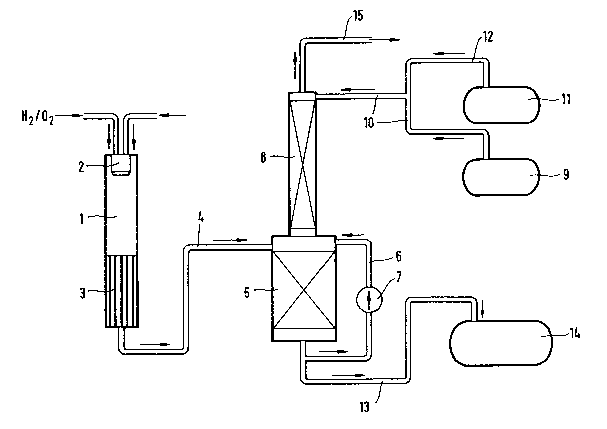Some of the information on this Web page has been provided by external sources. The Government of Canada is not responsible for the accuracy, reliability or currency of the information supplied by external sources. Users wishing to rely upon this information should consult directly with the source of the information. Content provided by external sources is not subject to official languages, privacy and accessibility requirements.
Any discrepancies in the text and image of the Claims and Abstract are due to differing posting times. Text of the Claims and Abstract are posted:
| (12) Patent Application: | (11) CA 2128659 |
|---|---|
| (54) English Title: | PROCESS FOR THE DISPOSAL OF HALONS OR HALON-CONTAINING FLUOROCARBONS OR CHLOROFLUOROCARBONS |
| (54) French Title: | PROCEDE POUR L'ELIMINATION DE HALONS OU DE FLUOROCARBURES OU CHLOROFLUOROCARBURES EN CONTENANT |
| Status: | Deemed Abandoned and Beyond the Period of Reinstatement - Pending Response to Notice of Disregarded Communication |
| (51) International Patent Classification (IPC): |
|
|---|---|
| (72) Inventors : |
|
| (73) Owners : |
|
| (71) Applicants : |
|
| (74) Agent: | SMART & BIGGAR LP |
| (74) Associate agent: | |
| (45) Issued: | |
| (22) Filed Date: | 1994-07-22 |
| (41) Open to Public Inspection: | 1995-01-25 |
| Examination requested: | 2001-07-05 |
| Availability of licence: | N/A |
| Dedicated to the Public: | N/A |
| (25) Language of filing: | English |
| Patent Cooperation Treaty (PCT): | No |
|---|
| (30) Application Priority Data: | ||||||
|---|---|---|---|---|---|---|
|
-1-
Abstract of the Disclosure
Process for the disposal of halons or halon-containing
fluorocarbons or chlorofluorocarbons
The invention relates to a process for the disposal of
halons or halon-containing FCs or CFCs, wherein the
latter are thermally or photochemically decomposed in the
presence of a hydrogen source, the gas produced,
containing HF, HBr, CO2, water and, if appropriate, HCl,
is cooled, the hydrogen halides are absorbed in a
scrubbing liquid in a gas scrubber column and neutralized
with a base, and any elemental bromine or chlorine
contained in the gas is reduced to the corresponding
salts with a reducing agent.
Note: Claims are shown in the official language in which they were submitted.
Note: Descriptions are shown in the official language in which they were submitted.

2024-08-01:As part of the Next Generation Patents (NGP) transition, the Canadian Patents Database (CPD) now contains a more detailed Event History, which replicates the Event Log of our new back-office solution.
Please note that "Inactive:" events refers to events no longer in use in our new back-office solution.
For a clearer understanding of the status of the application/patent presented on this page, the site Disclaimer , as well as the definitions for Patent , Event History , Maintenance Fee and Payment History should be consulted.
| Description | Date |
|---|---|
| Inactive: IPC deactivated | 2011-07-27 |
| Inactive: First IPC assigned | 2007-01-02 |
| Inactive: IPC assigned | 2007-01-02 |
| Inactive: IPC expired | 2007-01-01 |
| Inactive: IPC from MCD | 2006-03-11 |
| Inactive: IPC from MCD | 2006-03-11 |
| Time Limit for Reversal Expired | 2005-07-22 |
| Application Not Reinstated by Deadline | 2005-07-22 |
| Deemed Abandoned - Failure to Respond to Maintenance Fee Notice | 2004-07-22 |
| Letter Sent | 2001-07-20 |
| Inactive: Status info is complete as of Log entry date | 2001-07-20 |
| Inactive: Application prosecuted on TS as of Log entry date | 2001-07-20 |
| Request for Examination Requirements Determined Compliant | 2001-07-05 |
| All Requirements for Examination Determined Compliant | 2001-07-05 |
| Application Published (Open to Public Inspection) | 1995-01-25 |
| Abandonment Date | Reason | Reinstatement Date |
|---|---|---|
| 2004-07-22 |
The last payment was received on 2003-06-03
Note : If the full payment has not been received on or before the date indicated, a further fee may be required which may be one of the following
Please refer to the CIPO Patent Fees web page to see all current fee amounts.
| Fee Type | Anniversary Year | Due Date | Paid Date |
|---|---|---|---|
| MF (application, 3rd anniv.) - standard | 03 | 1997-07-22 | 1997-06-27 |
| MF (application, 4th anniv.) - standard | 04 | 1998-07-22 | 1998-05-29 |
| MF (application, 5th anniv.) - standard | 05 | 1999-07-22 | 1999-05-28 |
| MF (application, 6th anniv.) - standard | 06 | 2000-07-24 | 2000-06-01 |
| MF (application, 7th anniv.) - standard | 07 | 2001-07-23 | 2001-07-04 |
| Request for examination - standard | 2001-07-05 | ||
| MF (application, 8th anniv.) - standard | 08 | 2002-07-22 | 2002-06-14 |
| MF (application, 9th anniv.) - standard | 09 | 2003-07-22 | 2003-06-03 |
Note: Records showing the ownership history in alphabetical order.
| Current Owners on Record |
|---|
| SOLVAY (SOCIETE ANONYME) |
| Past Owners on Record |
|---|
| ROLF-MICHAEL JANSEN |
| RUDIGER WALZ |
| THEODOR AUEL |
| WOLF-DIETMAR KAUFMANN |